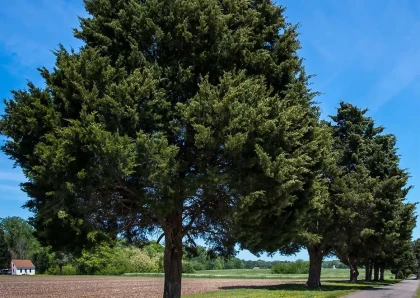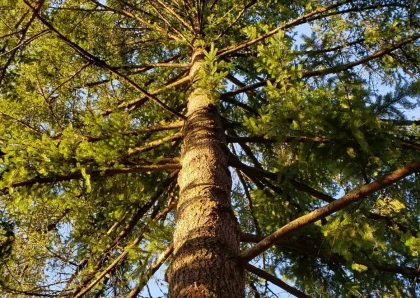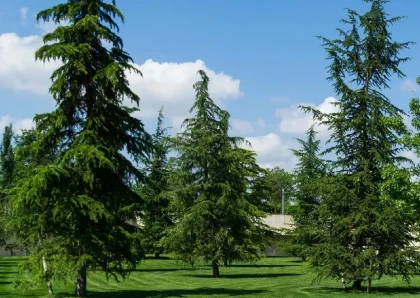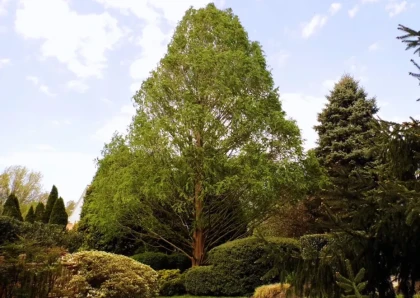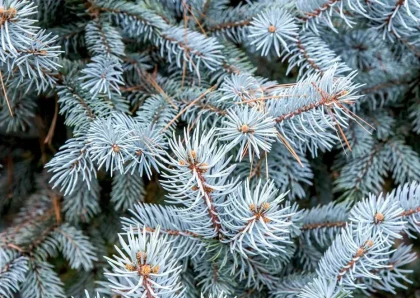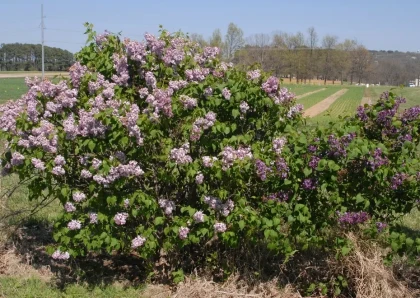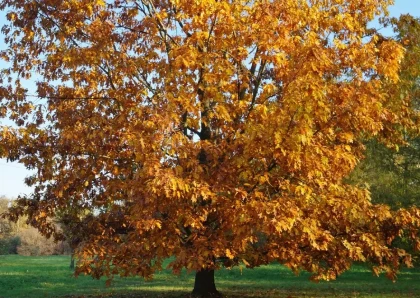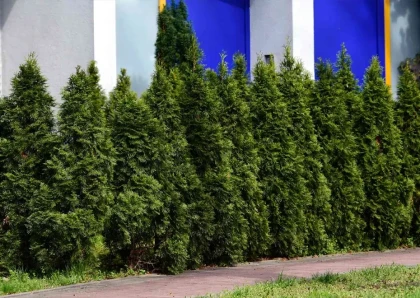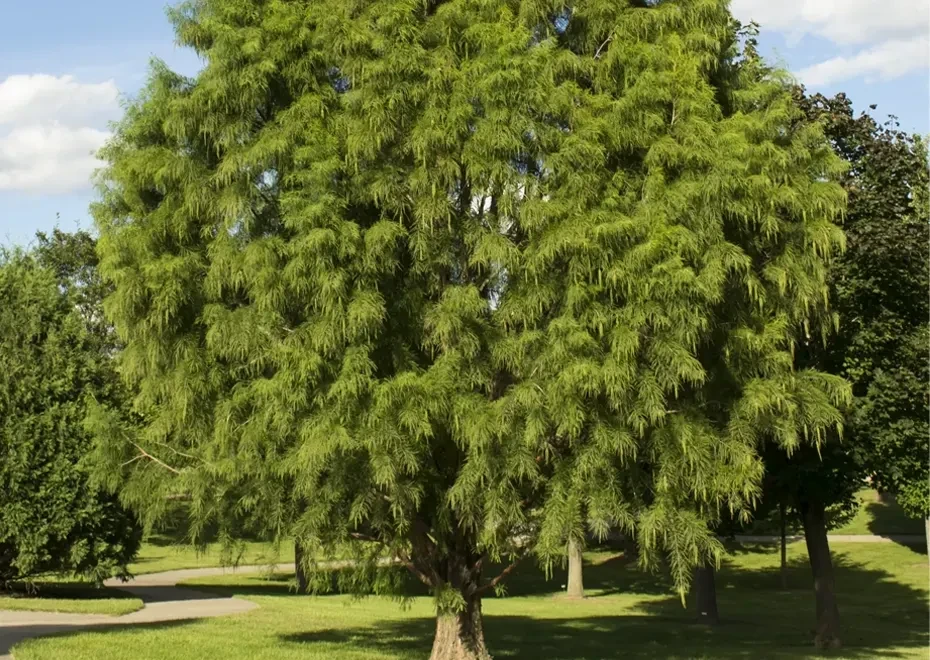
Bald Cypress Tree
Overview
Description
The Bald Cypress tree (Taxodium distichum) is a deciduous coniferous tree native to the southeastern United States and can also be found in parts of Mexico. Despite its name, the Bald Cypress is not a true cypress tree, but rather belongs to the family Cupressaceae.
Key features of the Bald Cypress tree include:
Leaves:
The leaves of the Bald Cypress are needle-like and arranged in two rows along the twigs, which gives it the species name "distichum," meaning "in two rows." The leaves are green during the growing season and turn rusty brown before falling off in the autumn.
Bark:
The bark of the Bald Cypress is reddish-brown and becomes fibrous and peeling with age.
Cones:
The tree produces small, round, and woody cones that are approximately 2 cm in diameter. These cones disintegrate to release their seeds in the fall.
Habitat:
Bald Cypress trees are commonly found in swampy and wetland areas, such as swamps, marshes, riverbanks, and floodplains. They are well-adapted to waterlogged soils and can tolerate both freshwater and brackish water conditions.
Adaptability:
Bald Cypress trees are known for their ability to survive in flooded or saturated soil conditions, thanks to their "knees" – cone-shaped projections that protrude from the roots and extend above the water's surface. The exact purpose of these knees is not fully understood, but they may help the tree obtain oxygen in waterlogged environments.
Size:
Bald Cypress trees are typically large and can reach heights of 100 to 120 feet (30 to 36 meters) or even taller under favorable conditions.
Lifespan:
Some Bald Cypress trees are known for their longevity and can live for hundreds or even over a thousand years.
Bald Cypress trees are highly valued for their ornamental and ecological significance. They are often planted in urban and suburban landscapes for their attractive foliage, unique appearance, and ability to thrive in wet conditions. Additionally, their extensive root systems help stabilize soil and reduce erosion in riparian areas.
In addition to their aesthetic value, Bald Cypress trees also play a vital role in supporting diverse ecosystems. They provide habitat for various wildlife species, such as birds, mammals, and insects, and contribute to the overall health and biodiversity of wetland environments.
Types of Bald Cypress Trees
Taxodium distichum 'imbricatum'
This variety is commonly referred to as the "Pond Cypress." It is similar to the typical Bald Cypress, but it tends to have a more pyramidal shape. Pond Cypress is often found in swamps and wetland areas, and its needles are often more crowded on the branchlets.
Taxodium distichum 'nutans'
Also known as the "Pendula" or "Weeping Bald Cypress," this variety is notable for its drooping branches and weeping appearance. It is often planted for its unique and graceful form in ornamental landscapes.
Taxodium distichum 'mexicanum'
This variety is commonly called the "Montezuma Cypress" or "Mexican Cypress." It is native to parts of Mexico and Central America. Montezuma Cypress trees are generally larger and taller compared to the typical Bald Cypress.
Taxodium distichum 'mickelsonii'
Also known as the "Shawnee Brave Bald Cypress," this variety is known for its compact size and conical shape. It is a cultivar selected for its attractive and uniform appearance, making it a popular choice for landscaping.
Taxodium distichum 'peve minaret'
This variety is a dwarf cultivar known as the "Peve Minaret Bald Cypress." It has a dense, compact, and columnar growth habit, making it suitable for smaller garden spaces or container planting.
Taxodium distichum 'viridis'
The "Green Bald Cypress" or "Green Swamp Cypress" is a variety that is often found in swamps with slower-moving or standing water. Its foliage tends to have a vibrant green color, which adds to its ornamental appeal.
Wood Products from the Bald Cypress Tree
Lumber
Bald Cypress wood is commonly used to produce lumber for various construction purposes, including building frameworks, siding, decking, and interior paneling. Its resistance to decay and durability make it suitable for outdoor applications.
Flooring
Bald Cypress wood is processed into flooring materials, offering an attractive and durable option for homes and commercial spaces. The wood's unique grain patterns and warm color enhance the aesthetic appeal of interior spaces.
Cabinetry
The wood from the Bald Cypress tree is popular for crafting high-quality kitchen and bathroom cabinets. Its natural beauty, combined with its strength and stability, makes it an excellent choice for cabinetry.
Furniture
Bald Cypress wood is used in the construction of various furniture items, such as tables, chairs, cabinets, and bookshelves. The wood's fine grain and ability to take on finishes well contribute to its popularity in furniture making.
Boat Building
Due to its natural resistance to rot and water damage, Bald Cypress wood is favored for boat building, particularly for creating boat hulls, decks, and other marine applications.
Siding and Cladding
Bald Cypress wood is utilized for exterior siding and cladding on buildings. Its weather-resistant properties and natural resistance to insects and decay make it a durable option for protecting structures.
Shingles and Roofing
Bald Cypress wood is used to produce wooden shingles and shakes for roofing applications. These shingles offer an attractive, rustic appearance and can provide excellent insulation for homes.
Pergolas and Gazebos
Bald Cypress wood is ideal for constructing pergolas, gazebos, and other outdoor structures due to its ability to withstand weather exposure and its appealing appearance.
Decorative Items
Bald Cypress wood is also used for crafting various decorative items, such as carvings, sculptures, and wooden ornaments, thanks to its workability and attractive grain patterns.
Interior Trim and Molding
The wood from the Bald Cypress tree is used to create interior trim and molding, adding decorative details and elegance to doors, windows, and walls.
Benefits of the Bald Cypress Tree
Environmental Adaptability
Bald Cypress trees are highly adaptable to various environmental conditions, including swampy and waterlogged areas. They can thrive in both freshwater and brackish water conditions, making them valuable for stabilizing wetland ecosystems.
Erosion Control
The extensive root systems of Bald Cypress trees help reduce soil erosion along riverbanks, floodplains, and wetlands. Their root "knees" also play a role in stabilizing the trees in waterlogged environments.
Water Quality Improvement
Bald Cypress trees can improve water quality by filtering pollutants and excess nutrients from the surrounding water, helping to maintain healthier aquatic ecosystems.
Wildlife Habitat
These trees provide vital habitat for various wildlife species, including birds, mammals, and insects. Their presence in wetland areas supports biodiversity and enhances ecological balance.
Carbon Sequestration
Bald Cypress trees, like all trees, play a crucial role in carbon sequestration. They absorb carbon dioxide from the atmosphere and store carbon in their biomass, helping to mitigate the impacts of climate change.
Lumber and Wood Products
The wood of Bald Cypress trees is highly valued for its durability and resistance to decay. It is commonly used to produce lumber for construction, flooring, cabinetry, furniture, and boat building.
Ornamental Value
Bald Cypress trees are widely planted for their ornamental value in landscapes and urban areas. Their unique shape, attractive foliage, and changing colors throughout the seasons add aesthetic appeal to parks and gardens.
Flood Control
Bald Cypress trees can act as natural buffers during floods, absorbing and storing excess water, thereby reducing flood risk in low-lying areas.
Recreational Opportunities
Public areas with Bald Cypress trees offer recreational opportunities such as birdwatching, nature walks, and boating, enhancing the quality of life for nearby communities.
Longevity and Heritage
Some Bald Cypress trees are known for their exceptional longevity, with lifespans of hundreds or even thousands of years. They often become landmarks and symbols of heritage in their regions.
Cons of Using the Bald Cypress Tree
Large Size
Bald Cypress trees can grow to be quite large, which may not be suitable for small yards or urban landscapes with limited space.
Slow Growth Rate
These trees have a relatively slow growth rate, which may require more time to reach desired sizes for some applications.
Messy Dropping
Bald Cypress trees shed leaves, cones, and small branches regularly, which can create a mess on lawns, walkways, and driveways, necessitating regular cleanup.
Potential for Property Damage
In windy or stormy conditions, the branches of Bald Cypress trees can be prone to breakage, leading to potential property damage or safety hazards.
Invasive Potential
In regions outside their native range, the Bald Cypress tree can become invasive and outcompete native plant species, disrupting local ecosystems.
Allelopathic Effects
Bald Cypress trees release certain chemicals that can inhibit the growth of other plant species nearby, potentially reducing plant diversity in the surrounding area.
Flood Risk in Urban Areas
In urban areas, planting Bald Cypress trees near structures may increase the risk of clogging drainage systems during heavy rains or flooding events.
Potential for Soil Acidification
Bald Cypress trees prefer acidic soils, and their needle drop can contribute to soil acidification over time, which may negatively impact other plants that prefer neutral or alkaline soils.
Allergenic Potential
Some people may be sensitive or allergic to pollen or other allergens released by Bald Cypress trees, leading to respiratory issues or allergies.
Maintenance Requirements
Regular maintenance, such as pruning and cleanup of fallen debris, may be necessary to manage the tree's growth and appearance.
Tips for Planting and Maintaining the Bald Cypress Tree
Planting
1. Site Selection:
Choose a planting location with full sun exposure and well-draining soil. Bald Cypress trees are highly adaptable to various soil types but thrive in moist, acidic to neutral pH soils.
2. Spacing:
Ensure enough space for the tree to grow to its mature size. Bald Cypress trees can become large, so consider their potential height and spread when planting to avoid crowding.
3. Planting Hole:
Dig a planting hole that is at least twice as wide as the root ball of the tree. The depth should be the same as the height of the root ball. Avoid planting too deep or too shallow.
4. Watering:
Water the tree thoroughly after planting to settle the soil and eliminate air pockets. Provide regular watering during the first year to help establish the root system.
5. Mulching:
Apply a layer of organic mulch around the base of the tree to retain moisture, suppress weeds, and protect the roots from temperature fluctuations. Keep the mulch away from the trunk to prevent rot.
6. Pruning:
Minimal pruning is usually required for Bald Cypress trees. Remove dead, damaged, or diseased branches as needed. Prune during late winter or early spring before new growth begins.
Maintenance
1. Watering:
Once established, Bald Cypress trees are generally drought-tolerant, but they still benefit from occasional deep watering during dry periods, especially in the first few years.
2. Fertilization:
Avoid excessive fertilization, as it can lead to rapid, weak growth. Apply a balanced fertilizer sparingly in the spring if necessary, following soil test recommendations.
3. Disease and Pest Management:
Regularly inspect the tree for signs of diseases or insect infestations. Promptly address any issues by consulting with an arborist or horticulturist for appropriate treatments.
4. Mulching:
Replenish the mulch layer around the tree every year to maintain its benefits, but avoid piling mulch against the trunk to prevent moisture-related issues.
5. Winter Protection:
In areas with harsh winters or heavy snowfall, consider wrapping young trees with burlap or using tree wraps to protect them from snow and ice damage.
6. Monitoring:
Keep an eye on the tree's health and growth. Look for signs of stress, such as yellowing needles or wilting branches, and take appropriate action if necessary.
Conclusion
The Bald Cypress tree (Taxodium distichum) stands as a remarkable and valuable species, showcasing its adaptability to diverse environments, ecological significance, and versatility for both environmental preservation and practical applications. With its enduring wood, ornamental value, and contribution to biodiversity, the Bald Cypress remains an essential and resilient species, enriching landscapes and providing valuable resources for various purposes.
FAQs
1. Are Bald Cypress trees evergreen or deciduous?
The Bald Cypress tree is deciduous, which means it sheds its leaves in the fall, turning rusty brown before they drop.
2. What are the "knees" seen around some Bald Cypress trees?
The "knees" are cone-shaped projections that emerge from the roots of Bald Cypress trees, often seen in waterlogged areas. Their exact purpose is not fully understood, but they may assist the tree in obtaining oxygen in waterlogged environments.
3. Do Bald Cypress trees grow well in wetland areas?
Yes, Bald Cypress trees are well-adapted to wetland environments and can thrive in swampy and waterlogged areas. They are often found in swamps, marshes, riverbanks, and floodplains.
4. How tall do Bald Cypress trees typically grow?
Bald Cypress trees can reach heights of 100 to 120 feet (30 to 36 meters) or even taller under favorable conditions.
5. What is the lifespan of a Bald Cypress tree?
Some Bald Cypress trees are known for their exceptional longevity and can live for hundreds or even over a thousand years.
6. Can Bald Cypress trees tolerate flooding?
Yes, Bald Cypress trees are highly adapted to tolerate flooded or waterlogged conditions, and their extensive root systems help them thrive in such environments.
7. Is the wood of Bald Cypress trees durable?
Yes, Bald Cypress wood is highly durable and naturally resistant to decay, making it a valuable resource for various construction and woodworking applications.
8. Can Bald Cypress trees be planted in urban landscapes?
Yes, Bald Cypress trees are often planted in urban and suburban landscapes for their ornamental value and ability to thrive in wet conditions. However, their large size should be considered when choosing a planting location.
9. Do Bald Cypress trees attract wildlife?
Yes, Bald Cypress trees provide habitat for various wildlife species, including birds, mammals, and insects, making them valuable contributors to local ecosystems.
10. Are Bald Cypress trees suitable for woodworking?
Yes, Bald Cypress wood is favored in woodworking for its workability, attractive grain patterns, and resistance to decay, making it ideal for crafting various wood products.




